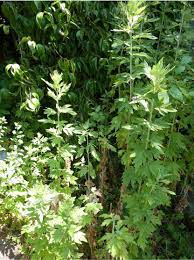 An herb beloved by both Eastern and Western herbal traditions, Ai Ye or Mugwort (Artemisia Argyi or Artemisia Vulgaris), is an emblem of healing and protective power.
An herb beloved by both Eastern and Western herbal traditions, Ai Ye or Mugwort (Artemisia Argyi or Artemisia Vulgaris), is an emblem of healing and protective power.
Indeed, acupuncture has been entwined with this herb since its origins through its crucial role in moxibustion, in which a refined wool “floss” made from the herb is burned directly or indirectly as cones, sticks, or atop needles to warm the acupuncture points and channels.
As the earliest of Chinese Medicine Classics state:
“A disease that may not be treated by acupuncture may be treated by moxibustion.”
“When a disease fails to respond to herbs and acupuncture, moxibustion is suggested.” (Lingshu, Chapter 73)
An Herb that Retains Yang to Treat Cold
Seeing the Ai Ye reach its peak in the sunniest portion of the front ACTCM Herb Garden is a sign of the most Yang season. It is harvested a few days before the Summer Solstice just before it is about to flower. It has been traditionally harvested in this way on either the third day of the third lunar month or the fifth day of the fifth lunar month for three thousand years. The Ai Ye is harvested when the moon is waxing, the Yang is increasing, and the Sun is at its highest point in the sky. It is harvested at this time in order to retain the Yang potency in the leaves to most effectively clear away cold stagnation and its associated medley of diseases within the body.
During Ai Ye harvest time we witness the expansive, energetic quality of Summer to its almost feverish and manic pitch before the first Yin of the proceeding Fall intrude. It is the time of the Duan Wu, “Double Five” or Dragon Boat Festival, when the active Yang energy is expressed symbolically in boat races and the auspicious mytho-poetic Yang animal, the Dragon. Mugwort is hung upon doors, throughout homes, and carried in incense bags promising protection for the coming year – a likely association since it has such sensational ability to burn away disease within the body.
The Global Tradition of Mugwort
The Latin name Artemisia is a namesake of the Greek Goddess Artemis or Diana who was associated with the fertility of nature, and the herb has had special significance to assist the regulation of menses, within both Western and Eastern herbal tradition. It is native to both Asia and Europe, although it has naturalized in much of the rest of the world. Some see it as an invasive weed, because of its ability to survive and proliferate. It has been an important herb in many folk medicines. Douglasiana, a species native to Southwestern North America was utilized by many Native Tribes as “Dream Sage,” encouraging lucid dreams and eliciting dreamlike states. Mugwort was used in this way by European herbcraft as well.
A Tenacious and Powerful Herb That Surrounds Us
I personally find inspiration in the commonness and tenacity of this herb, its ability to survive and thrive any condition – from tiny sidewalk cracks of urban metropolises to drought wastelands of California, or disturbed soils of forest hedges. It is prolific medicine and food to many, and seems to whisper some hidden message about survival. It grows somewhat aggressively when given room, and aims itself tall, toward the sun. As a burning agent in the acupuncture clinic, it can flip babies in the womb, and move Blood and Qi, deeply warming the Channels. Give thanks to this wonderful plant the next time you see it, whether you’re stepping around it on a walk, giving it a sprinkle of water, or yanking it out of your Canadian homestead garden. Ai Ye provides powerful medicine to our practice.
Click here to view upcoming ACTCM events.
About American College of Traditional Chinese Medicine
American College of Traditional Chinese Medicine (ACTCM) has provided affordable, quality health care to the public and trained professionals in acupuncture, massage and Chinese medicine since 1980. In addition to its graduate curriculum, ACTCM offers continuing education, public education, community outreach and clinical services in acupuncture and herbal medicine. ACTCM has been the recipient of many awards for its curriculum, faculty and clinic, and has been voted “Best of the Bay” by both the San Francisco Weekly and the San Francisco Bay Guardian. ACTCM is accredited by the Accreditation Commission for Acupuncture and Oriental Medicine and is a private, nonprofit, 501(c)(3) tax-exempt organization